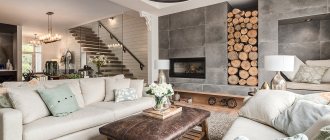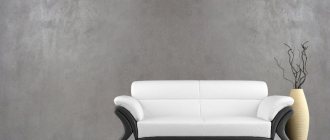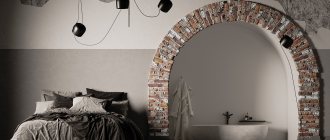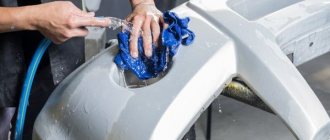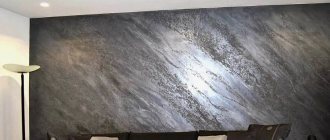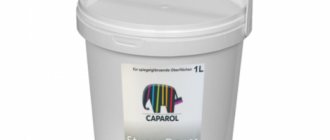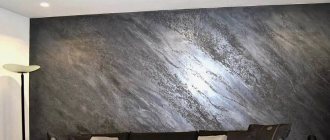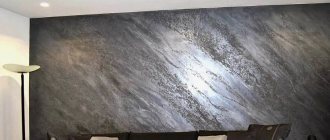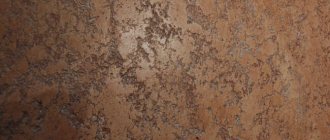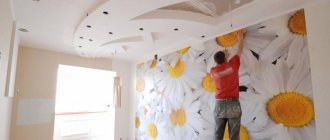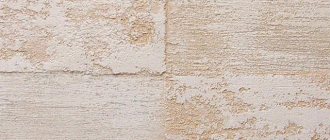Decorating the surface for concrete
Plaster that imitates the surface of concrete has become a popular type of decoration for rooms in the minimalist style. Walls with a “concrete effect” look durable, solid, monumental, even if they are built from plasterboard.
Users are attracted not only by the illusion of strength and reliability, but also by the minimalism of appearance. Plastered in this way, the wall imitates the surface before the renovation began. But when looking at her, there is no feeling of incompleteness.
Decorative plaster for concrete in the interior in this style is usually performed in rooms with a simplified, at first glance, general design.
Advantages and disadvantages
Let's say you're interested in decorating the walls with decorative plaster to look like concrete. It looks really impressive. But before you buy it, think about whether this is the material you need. Any finishing method has its advantages and disadvantages, and you need to know them in advance. Let's start with the positives. This:
Durability . Such a coating will not lose its appearance and will protect the walls from cracking. Concrete plaster will withstand high temperatures, some types are also moisture resistant. This is a universal material for all types of premises.
Safety . The material is not flammable and does not emit toxic substances into the air. And bacteria and mold do not multiply in it.
Easy to use . You can plaster concrete walls yourself. And decorative plaster is placed on any base: concrete, brick, wood and even metal.
Comfort in use . No special care requirements: such walls are easy to clean. Plaster also has heat and sound insulating properties.
Aesthetics . Seamless coating. Concrete plaster perfectly masks unevenness and defects in walls, so it will look decent even without prior leveling. You can create many different designs with the same mixture if you get creative.
“Concrete” wall decoration fits anywhere: loft, pop art, Scandinavian style, eco, steampunk. Concrete looks both noble and modern. Combines with wood, glass, metal, plastic and textiles. If we talk about decorative plaster in general, the possibilities are endless. For example, Venetian marbled plaster looks organically in classic, rococo, and empire style.
What's the catch?
- Firstly, the high price. Everything, of course, is relative; this is not the most expensive material for wall decoration, but not the cheapest either. Multiply the price by a rather large expense - and all this will result in a significant amount.
- Secondly, in drying time. Even in a dry room, the plaster can take 1-2 weeks to dry. But, of course, this depends on the composition of the plaster.
- And thirdly, such finishing will be difficult to dismantle. It's worth thinking carefully about the design of the room before you start.
If these features don’t scare you, then let’s move on to the process of working with decorative plaster.
Matching style
A minimum of things, furniture, muted colors, and discreet decor are generally called high-tech style. Premises decorated in this way can be used as a club or restaurant, as a rock studio or creative workshop, as a formal office space or as the home of a person who understands and loves art.
But there are no strict rules for home design. Therefore, in some cases it is advisable to install a bright sofa in the room or decorate one of the walls with abundant living greenery or flowers. Lighting is important, because twilight in a home with “concrete” walls causes a negative mood.
Without good lighting, such a room will look gloomy Source zebra100.ru
It is recommended to design concrete-look walls in rooms with high ceilings, preferably in large areas. A large space with bright lighting is associated with the naturalness of the loft style.
Video lessons
How to do plastering in a loft style, watch the video:
Video from finishing master Roman Odarchenko : plastering to look like “concrete” using ordinary polymer putty Ceresit CT 95.
In the next master class, golden mica is mixed into the Art-concrete plaster. Looks very cool!
We hope that the article was useful to you. Leave your feedback and questions in the comments below.
Previous
Decorative plasterTravertine: modern classics in stone-like plaster
Next
Decorative plasterWhat is “microcement”, “microconcrete” and how to work with them
Composition of the plaster mixture
Manufacturers offer ready-made plaster mixtures in various versions. Conventionally, they can be divided into two groups: microcement and microconcrete. Both categories contain:
- Finely ground cement;
- Seeded sand of minimum fraction, cleared of impurities;
- Polymer additives that give the compositions specific properties.
In addition to the listed components, microconcrete contains mineral additives of a slightly larger fraction.
The ingredients are usually indicated on the packaging. The manufacturer's recommendations, rules for preparing the surface, mixing the mixture and applying plaster are also written there.
Examples of wall textures “like concrete” Source o-remonte.com
See also: Catalog of companies that specialize in finishing materials.
How to make plaster for concrete - do-it-yourself composition
Store-bought decorative plaster that imitates concrete can cost a lot, but you can prepare a similar mixture yourself. There are several options for creating a composition, among which the two most common are:
- Manufactured on the basis of cement or gypsum plaster with the addition of putty and coloring pigment. To obtain the required shade, you will need to carry out tinting in several passes, clearly measuring the amount of dye, so that you can prepare an identical solution if necessary.
- The plaster mixture can be made from a gypsum mixture and water. To increase plasticity properties, as well as improve adhesion, polyvinyl acetate glue is used as a binder, at the rate of 200 ml per 5 kg of gypsum.
If possible, it is better to purchase a ready-made mixture, since failure to comply with the proportions when making it yourself can negatively affect the quality and appearance of the decorative plaster.
Properties and advantages of plaster
In addition to its appearance, which can be combined with any materials in the interior, decorative plaster “concrete” has a number of positive characteristics. The list of advantageous properties that allow us to consider the material universal and accessible in use:
- does not respond even to significant changes in humidity and air temperature in the room;
- does not require regular care;
- the plaster layer performs the function of retaining heat in the room, allowing you to significantly reduce heating costs;
- does not exert additional load or other undesirable effects on the original surface;
- easy to paint with any composition;
- can be used for an extremely long time without changing properties;
- applied to any surface with a high degree of adhesion;
- does not require high-quality smoothing or grinding;
- allows the use of stencils and stamps;
- work on applying plaster does not require high professional training;
- the surface texture is selected at the user’s request;
- Surface shades can be varied by adding regular acrylic dyes.
The addition of dyes makes the plaster more beautiful Source beton-house.com
What is art concrete
Art concrete is a plastic, durable and easy-to-work material that is used where ordinary concrete will not allow the task to be completed. Archstone resembles plasticine, so you can use it to create a variety of decorative elements, complex shapes for decorating construction sites and sites - figures, stucco molding, statues, columns, openwork latticework, park sculptures, etc.
When asking questions about whether architectural concrete is relevant when performing specific work, what it is and how to make it, you can briefly explain it this way: it is ordinary concrete with various admixtures that provide useful characteristics of the material: increase durability, add color, texture, etc. d.
Artistic concrete is produced from a sand-cement mixture, adding various additives to regulate decorative properties and technological parameters - pigment to achieve the desired color, level of strength, ductility, resistance to temperature changes and moisture, hardening time, etc.
Main components of the material:
- Water
- Portland cement
- Quartz sand, marble chips (coarse or fine aggregate)
- Pigment
- Additives to obtain the desired properties (modifying, reinforcing)
In appearance, the material is similar to natural wild stone; it allows you to beautifully design buildings and territories, significantly saving on decorative finishing. Like other types of concrete, archstone is standardized by state standards: GOST 26633-2015, GOST 25192-2012. Plastering and finishing composition can be purchased in specialized stores or made independently according to a recipe.
Characteristics and composition of the material
Any art concrete has high strength. On average, it is 39 MPa 3 days after setting and 59 MPa after 28 days. The whiteness of the finished composition varies between 68-85%, the minimum frost resistance is 100 cycles of freezing and thawing. Art concrete sets quickly and gains strength after 15 hours.
The basic composition of the material is not fundamentally different from classical solutions. Art concrete includes a binder component - Portland cement of white, light gray color M400 or M500 strictly without foreign inclusions and lumps. M600 and M700 cements are used much less frequently for the production of mixtures. The composition also includes quartz sand, which can be partially (up to 5-10%) replaced with granite, marble chips or glass powder.
In addition, art concrete may include other ingredients:
- fine-grained crushed stone, pebbles, shells of a certain shade (to add decorativeness);
- plasticizers, curing regulators, additives to enhance frost resistance, water repellents;
- fiberglass or other reinforcing fibers.
Pigments can be added to the mixture so that it immediately acquires the desired color. Also, purified water in a certain amount is used to prepare the material. In addition to the main binder (cement), art concrete may also include other components with similar properties:
- Acrylic (acrylic resin). The finished material dries quickly, has high elasticity, is easier to tint, and is suitable for rooms with unstable humidity and temperature. The service life of art concrete increases to 10-15 years.
- Minerals - clay, lime, gypsum. They make the composition more decorative, increase abrasion resistance, and provide fire safety.
- Silicates. Provide the highest resistance to damage and chemicals, and repel water. They are used if art concrete is intended for outdoor use.
- Silicone. Gives plasticity, strength, resistance to moisture and ultraviolet radiation.
How is architectural concrete different from ordinary concrete?
The basic composition of both types is the same. As already mentioned in the previous section, these are crushed stone, sand, water, plasticizers.
- To obtain architectural concrete (art concrete), colored pigments are added to the raw material to add color, ceramic chips for texture, or colored glass.
- To ensure that the color is uniform and consistent, special levelers are added.
- More plasticizers are also often included if the material will be created into complex shapes.
Decorative concrete in the interior is part of it; it looks complete and expressive, in harmony with the overall decor.
Disadvantages of exclusive plaster options
Plaster has practically no disadvantages. In technological terms, some difficulties may be caused by the length of time the mixture hardens. But this indicator is not critical - it is somewhat worse from the economic side of the issue.
Creating exclusive interiors requires not only the cost of expensive raw materials, but also payment for design development and selection of individual mixture components.
Good design is far from the cheapest pleasure Source market.kz
Decorative plaster-concrete - application features
The main features of using decorative material are related to the ability to create various effects:
- imitation of fresh concrete mass;
- reproduction of a rusty base;
- creating the illusion of a moistened façade cladding.
The originality of the base is achieved in various ways:
- adding a dye that creates a feeling of increased space due to the cold color scheme of the base;
- a combination of colors with sharply contrasting interior items made of leather, metal or plastic;
- painting the recessed or protruding planes of the relief pattern in one color;
- creating deliberate sloppiness and unevenness in the application of the relief texture.
Increased plasticity and a long hardening period allow you to create the desired relief and, if necessary, make adjustments to the texture.
Peculiarities
When choosing a composition, you should take into account the individual characteristics of not only the room being decorated, but also the concrete plaster itself in the interior:
- The structure of the plaster is porous and the surface is rough, this is caused by the content of mineral fillers and additives in it;
- The relief of the coating is achieved by sequentially applying several layers of the mixture;
- Preliminary preparation of the surface to be plastered consists of cleaning it from dust, dirt, and previous coatings;
- During work, you should use personal protective equipment, since the mixtures contain polymers that are harmful to health.
An example of combining plaster and other finishes Source connexionav.com
Famous manufacturers
Many manufacturers have responded to customer demand: there are more “concrete-like” coatings on the decorative plasters market. Let's see what different brands offer.
